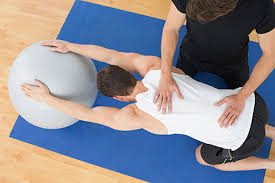Sports medicine physical therapy is becoming an increasingly popular treatment option for athletes of all ages. If you are suffering from an injury, sports medicine physical therapy may be the right choice for you. In this blog post, we will discuss the basics of sports medicine and physical therapy and how they can help you recover from your injury.
Contents
Understanding Sports Medicine Physical Therapy

Sports medicine physical therapy is a branch of physical therapy that specifically deals with the rehabilitation of athletes. It is used to help athletes recover from injuries and improve their performance.
Sports medicine physical therapists use a variety of techniques to assess and treat their patients. They may use traditional methods such as X-rays and MRIs, or more innovative techniques such as biofeedback and electrical stimulation.
The goal of sports medicine physical therapy is to help athletes return to their previous level of function as quickly and safely as possible. Treatment plans are individualized based on the athlete’s specific needs.
Common injuries that sports medicine physical therapists treat include:
- Achilles tendon injuries
- Ankle sprains
- Elbow injuries
- Groin strains
- Hamstring strains
- Knee injuries
- Shoulder injuries
- Tennis elbow
Sports medicine physical therapists work with athletes of all levels, from amateur to professional. They may work in a variety of settings, including outpatient clinics, hospitals, and sports training facilities.
If you are an athlete who is dealing with an injury, or if you are looking to improve your performance, consider seeing a sports medicine physical therapist.
Phases Of Sports Medicine Therapy

Sports medicine therapy is broken down into three phases.
Now that you know the three phases of sports medicine therapy, let’s take a more detailed look at each one.
Acute Phase
The first phase is the acute phase. This is when the injury just occurred and the focus of therapy is on pain management and protection of the injured area.
- The acute phase of sports medicine therapy usually lasts for the first few days after the injury occurred. The focus during this phase is on pain management and protection of the injured area.
- One of the most important things you can do during this phase is to ice the injured area for 15-20 minutes at a time, several times a day. This will help to reduce swelling and pain. You should also avoid putting any weight on the injured area and keep it elevated as much as possible.
- If you have a more serious injury, your therapist may use modalities such as electrical stimulation or ultrasound to help control the pain and swelling.
- You will likely also start some range of motion and strengthening exercises during this phase. These exercises will be focused on the uninjured parts of your body to help you stay active while your injury heals.
Sub-acute Phase
The second phase is the sub-acute phase. This is when the swelling has gone down and the focus of therapy is on regaining range of motion and strength.
The sub-acute phase of sports medicine therapy usually lasts for a few weeks after the injury occurred. The focus during this phase is on regaining range of motion and strength.
Ice will still be used during this phase to help control any residual swelling. You will likely also continue to use electrical stimulation or ultrasound if you were using it during the acute phase.
The exercises you do during this phase will be focused on regaining range of motion and strength in the injured area. These exercises will gradually become more challenging as you progress through this phase.
Chronic Phase
The third phase is the chronic phase. This is when the injury has healed and the focus of therapy is on preventing re-injury and improving performance.
- The chronic phase of sports medicine therapy usually lasts for several weeks to several months after the injury occurred. The focus during this phase is on preventing re-injury and improving performance.
- Ice will still be used during this phase to help control any residual swelling. You may also continue to use electrical stimulation or ultrasound if you were using it during the acute and sub-acute phases.
- The exercises you do during this phase will be focused on preventing re-injury and improving performance. These exercises will be more challenging than the ones you did during the sub-acute phase.
- You may also start to use sports training equipment during this phase to help you improve your performance.
- Now that you know the three phases of sports medicine therapy, you can work with your therapist to create a treatment plan that is right for you. Depending on the severity of your injury, you will likely progress through all three phases before you are fully recovered.
If you have any questions about sports medicine therapy, be sure to ask your therapist. They will be able to help you understand the process and what you can expect.
What Equipments Can Be Used?
There is a wide range of sports medicine and physical therapy equipment that can be used to help you heal from an injury and get back to your favorite activities. Your therapist will design a treatment plan specifically for you, based on the type of injury you have and your individual needs. Some of the common pieces of equipment you may use during your sessions include:
Exercise balls: These can be used to help improve your balance and coordination, as well as to help strengthen the muscles around your joints.
Weighted bars: These are often used during range-of-motion exercises to help increase the intensity of the workout.
Resistance bands: These provide resistance when you are stretching or doing other exercises, helping to improve your flexibility and range of motion.
Treadmills: Treadmills can be used for cardiovascular conditioning and to help increase your endurance.
Stationary bikes: Like treadmills, stationary bikes are often used for cardiovascular conditioning. They can also be helpful in strengthening the muscles in your legs.
Elliptical machines: Elliptical machines provide a low-impact workout that can be helpful for people with joint problems.
Your sports medicine physical therapist will help you choose the right piece of equipment for your individual needs and make sure you are using it correctly to get the most benefit from your therapy sessions.
What Are the Benefits of Sports Medicine and Physical Therapy?
Sports medicine physical therapy can offer a wide range of benefits, depending on your individual needs and goals. In general, sports medicine and physical therapy can help:
Reduce pain
By helping to stretch and strengthen the muscles around your joints, sports medicine physical therapy can help reduce the amount of pain you are experiencing from an injury. For example, if you have a sprained ankle, therapy can help reduce swelling and pain and improve your range of motion.
Improve range of motion
If you have an injury that limits your range of motion, sports medicine physical therapy can help improve it. For example, if you have had surgery on your knee, therapy can help you regain the full range of motion in that joint.
Improve range of motion
Stretching exercises and range-of-motion exercises can help improve the flexibility in your joints, making it easier for you to move them through their full range of motion.
Increase strength
Strengthening exercises can help to build the muscles around your joints, making them better able to support and protect your joints.
Improve balance and coordination
Balance and coordination exercises can help you move more smoothly and accurately, improving your performance in activities such as sports. For instance, working on your balance can help you maintain control while running or jumping.
Better posture and alignment
If you have good posture and alignment, your muscles can work more efficiently, saving energy and reducing your risk of injury. Physical therapists can show you how to stand, sit, and move in ways that put the least strain on your body.
Increase endurance
Cardiovascular conditioning exercises can help to increase your endurance, so you can participate in activities for longer periods of time without becoming too tired.
Prevent future injuries
Sports medicine physical therapy can help you improve your technique in activities such as running or other sports. This can help to prevent injuries by reducing the amount of stress on your joints and muscles.
It’s important to talk to your doctor before starting any new exercise program, especially if you have any health concerns. Your doctor can help you determine if sports medicine physical therapy is right for you and can provide you with guidance on how to stay safe while participating in activities.
What Are the Risks of Sports Medicine and Physical Therapy?
Sports medicine physical therapy is generally safe, but there are a few risks that you should be aware of before starting any new exercise program. They are:
1. Pain: While pain is a common symptom of many injuries, it is also a natural response to exercise. If you experience any pain during your workout, be sure to stop and rest.
2. Injury: Like any other physical activity, there is always the risk of injury when participating in sports medicine and physical therapy. However, the risk is generally low if you warm up properly and listen to your body.
3. Dehydration: It is important to stay hydrated when exercising, especially in hot weather. Be sure to drink plenty of fluids before, during, and after your workout.
4. Exhaustion: Sports medicine and physical therapy can be taxing on your body. If you feel tired or dizzy, be sure to take a break and rest.
5. Overuse: As with any physical activity, there is a risk of overuse injuries if you participate in sports medicine and physical therapy too frequently or for too long. Be sure to give your body adequate time to recover between workouts.
If you are new to physical activity, or if you have any medical conditions that might affect your ability to exercise safely, be sure to talk to your doctor before starting a new program.
Conclusion
It may be concluded that sports medicine physical therapy is an effective treatment option for a variety of sports injuries. It is important to consult with a qualified healthcare professional to determine the best course of treatment. Sports injury prevention is also a key element of sports medicine physical therapy. A comprehensive approach to injury prevention includes proper warm-up and cool-down techniques, strength and flexibility training, and the use of proper equipment.
Physical Therapy help patients recover from pain. If you’re experiencing Back pain, Shoulder pain, Knee pain, Neck pain, Elbow pain, Hip pain, or Arthritis pain, a physical therapist at MantraCare can help: Book a physiotherapy session.


